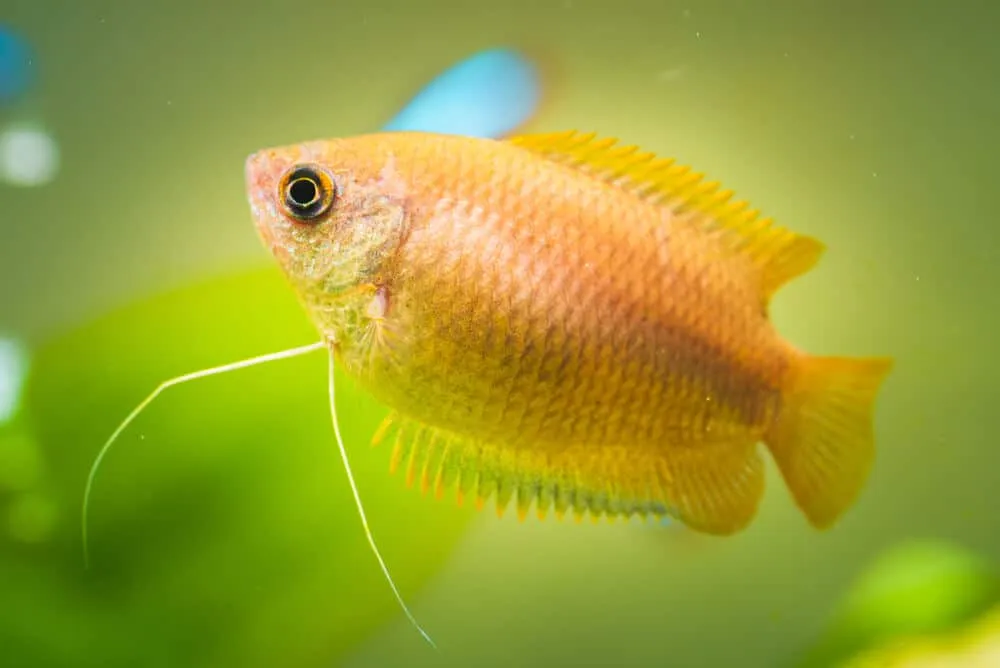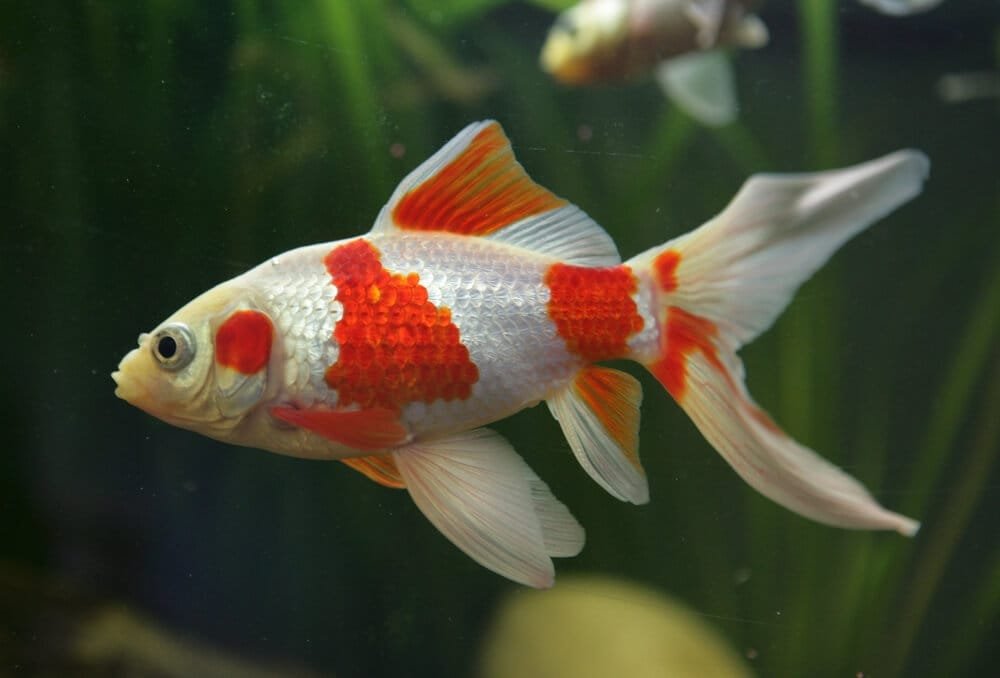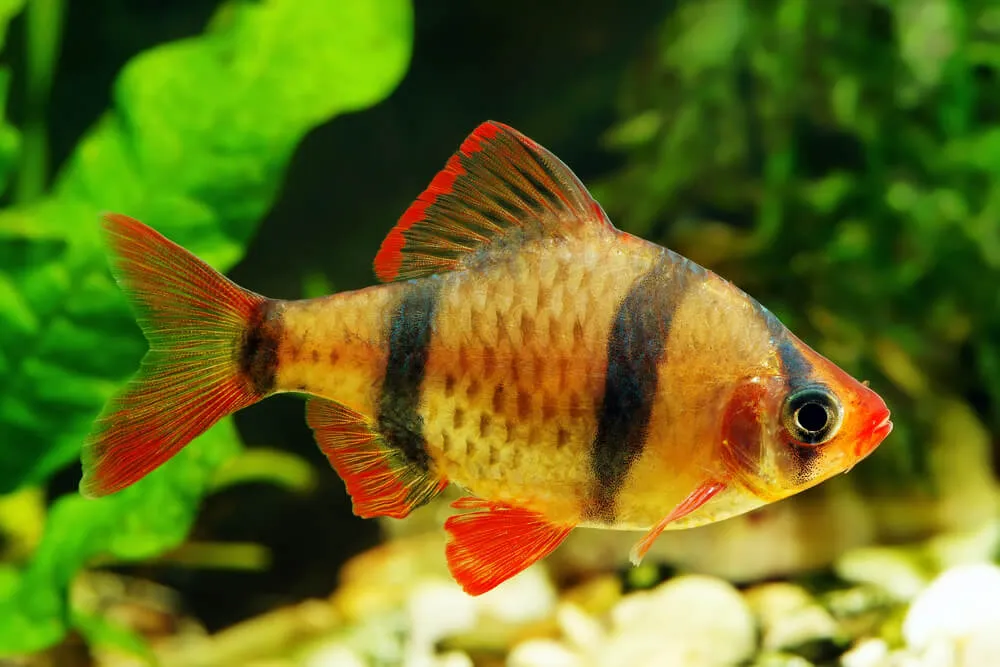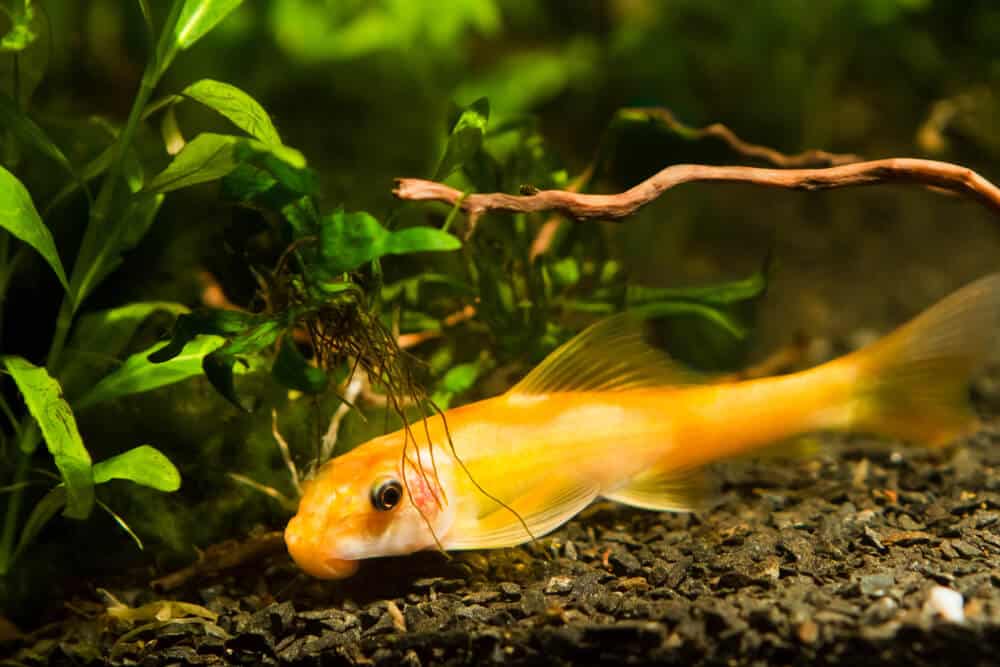Red Flame Honey Gourami: The Ultimate Beginner’s Guide

The red flame honey gourami is a delightful addition to anyone’s aquarium. It is colorful, peaceful, and easy to care for. If you’re looking to add color and life to your tank, make sure to include the honey gourami in your list!
The honey gourami is generally peaceful and doesn’t pick up fights with other fishes in the community tank that easily. They are honey-colored and have lovely markings, which make them attractive for every fishkeeper. Keep reading to learn more about this pet fish – including on care, feeding, and tank setup.
Overview Of The Red Flame Honey Gourami
The honey gourami is the perfect alternative for tank keepers looking for a betta substitute because they’re not as aggressive as other similar type species or too big to easily crowd a tank.
First time fishkeepers should not think twice about choosing the honey gourami because they’re hardy fishes and do not require much upkeep. Let’s discuss this more along with the following general information about these cute pets.
Francis Hamilton discovered the Trichogaster chuna, its scientific name, back in 1822. However, it wasn’t until the 1880s when they’re introduced to home aquariums. Since then, they became an instant crowd favorite.
The fish is called by many names, including Dwarf Fire Gourami, Red Flame Gourami, Red Robin Gourami, Red Fire Dwarf Gourami, Sunburst Gourami, and Red Honey Fire Gourami.
Males and females had been differently and mistakenly classified – the male being the Trichopodus chuna and the females the Trichopodus sota. Later on, the wrong classification was corrected, as the fish were discovered to be breeding together.
In the past, the honey gourami had also been confused with other species – the thick lipped gourami and the dwarf gourami. Aquarists weren’t able to distinguish which was which.
It was because the two other fishes were introduced to the fishkeeping scene at about the exact time as the honey gourami.
Some hobbyists were surprised to know that what they were keeping was a dwarf gourami or thick lipped gourami. But as time went by, tank keepers were able to distinguish the differences.
The honey gouramis belong to the Osphronemidae family, along with other types of gouramis and betta fishes. They’re distinct from their labyrinth organ that allows them to breathe dry air, making them hardy to live and survive in setups with little oxygen supply.
They’re relatively small, not overcrowding a tank easily – with males growing up to three inches long and females around two inches.
They need at least a 10-gallon tank to thrive in the tank, but other sources reveal a 20-gallon tank will be a good start.
They come from slow-flowing rivers in South Asia. Some people think that the fish is a dwarf gourami. However, they don’t carry iridovirus, which infects the species and causes an incurable disease.
This disease is the result of inbreeding and poor genetics and is in 25% of dwarf gouramis sold commercially.
The Red Fire Dwarf Gourami may be the better choice for tank keepers who wish to set up a community aquarium because they are smaller and less aggressive when compared to other dwarf gouramis.
Distribution countries include Nepal, Bangladesh, and India.
The fishes are available in colors, such as orange, gold, yellow, and red and grow from about two to three inches. They have a generally peaceful temperament and are easy to maintain.
Males can exhibit a golden yellow, red, orange, and yellow color, while females in gray, brown, or silver.
Their lifespan ranges from five to eight years if well-maintained. They have a minimum tank size requirement of 10 gallons and are overall compatible with bottom dwellers and cyprinids.
They have colorful morphs and possess an attractive appearance, making them a favorite among hobbyists.
The fish is sold at specialty tank suppliers and online retailers at a price ranging from $5 to $8 per fish.
Appearance
Generally, young males and females have the same brown and silver color, but as they reach adulthood, males change in color. Females stay the same color.
On the other hand, males develop bright colors. Their color is the easiest distinction to use when trying to decipher whether you have a male or female honey gourami.
In terms of their body shape and fins, they also are easy to recognize. The fins of the male are pointed, while the females have rounded fins at the tips. Females are also almost always rounded. Male and female body is wide in the middle and thin at both ends.
The red flame honey gourami has a total of seven fins, with their dorsal fin starting at the forehead and ending towards the caudal fin. The anal fin of the honey gourami is parallel to their dorsal fin on the ventral side.
Tucked close to their body, you’ll also notice a pair of very small pectoral fins. Part of their distinctive appearance lies on their long and filamentous pelvic fins.
However, be mindful when buying your honey gourami because you might be mistaken. That instead of the red honey gourami, you might get the honey dwarf gourami.
Here’s a little tip to spot the difference. The red honey gourami has a solid color, and it’s always that way. They’re in orange, yellow, or red.
The dwarf variants are yellow and have spots or stripes. They are in red, blue, or yellow color.
Food And Diet
The honey gouramis are omnivores. They love a combination of food, such as freeze dried bloodworms, fish flakes, pellets, live foods, and algae.
They also occasionally nibble on plants aside from small prey they can find in the wild or in captivity.
In the wild, the red honey gouramis feed on invertebrates and insects. Just like an archer fish, they are wise fishes that squirt their prey with water to distract and knock them down from the trees and leaves into the water. If you happen to have a paludarium, you’ll see this talent yourself.
To keep them happy, feed your pet fish with a combination of live prey, homemade fish food, or commercially-bought varieties, such as pellets and dry flakes.
However, buy varieties infused with vegetables and protein.
I also notice that these gouramis love munching on aquarium plants. Whenever they exhibit this behavior, give them trimmings when you prune the plants in your tank.
Overall, the Red Robin Gourami loves feeding on a wide range of foods, giving them nourishment and enjoyment. Here is what to generally feed your pets.
· Vegetable tablets
· Daphnia
· Pellets
· Flakes
· Microworms
· Mosquito larvae
· Shrimps
· Fruit flies
· Plant material
· Crickets
· Moina
· Tubifex
The problem is that the red honey gourami is rather peaceful and shy. They tend to be less aggressive in feeding, too.
When placed in a community aquarium, they might not eat enough if combined with aggressive fishes.
Thus, it can be hard to tell if they can get enough nourishment. I recommend feeding them at a different time than the rest of the fishes in your community tank.
Ideally, feed them once each morning and evening. Give only a little food to ensure that it’s consumed within three minutes.
Behavior And Temperament
The honey gourami is fun to look at especially when they’re feeling energetic during the daytime. You will find them active and swimming a lot when feeling comfortable and safe. Make sure to keep them away from stress. Maintain a clean tank and avoid overcrowding them.
Honey gouramis can also be shy and timid when they feel stressed especially if they have a tank mate that causes them stress. It is why it is important to choose their tank mates to ensure that they live a harmonious life in the community tank.
They can also feel this way if the water quality doesn’t feel right. When living in a poor water quality tank, you’ll notice that they’re hiding frequently and not swimming along with other fishes. You must also decorate your tank with hiding places and more plants to ensure that your pets can hide whenever they want.
When they’re free swimming, honey gouramis love hanging around the tank’s middle levels. But from time to time, you will notice that they’re swimming near the surface of the water to get some air.
The fish are not so social, though. A honey gourami might not even socialize with fishes of the same kind. They can be staying only by the side of their partner fish once they have paired off. They can ignore all the others, too.
The male fish, however, will be more aggressive especially when combined with other similar male species as well as similar-looking fishes like the dwarf gourami.
Ideally, you must consider the ratio of one male for every three females.
Breeding
They have an interesting breeding behavior, which you’ll find fascinating. The females will place the eggs in the bubble nests.
Your tank should have floating anacharis and its water level must be kept at a range between six to eight inches high.
Put your honey gourami pair into a breeding condition. Supply them with live prey thrice a day and raise the water temperature up to 79 degrees Fahrenheit.
The male will have a brighter color, indicating its readiness to breed. On the other hand, the abdomen of the female will expand due to the eggs.
When your fish is spawning, reduce the normal water level by up to eight inches, with a temperature raised to about 82 degrees Fahrenheit.
The male will wrap their partner, stimulating the spawning wherein they’ll lay their eggs in the water. The male gourami will catch the eggs and get them to the bubble nest.
Three hundred eggs can be laid in one spawning, typically in clusters or groups of about 20. These eggs will be fertilized once they’re in the nests.
The male will protect the nest with all his might until the eggs hatch and become larvae.
The larvae will use yolk sacs for two days. After two days, give liquid foods and infusoria, and then feed them with larval brine shrimp and micro worms after one week.
The young honey gouramis will have the same color in their early life.
Once they mature, like when the males turn into their adult colors, add them into the community tank.
Quick Points
· The male honey gourami will build the bubble nests.
· The pair will defend their spawning area.
· After the eggs are laid, remove the female.
· Once the eggs hatch, you must remove the male after a few days.
· Typically, eggs hatch after two days.
Tank Setup And Habitat
The fish is a natural dweller in the northern Ganges’ stagnant water, typically living in drainage basins, pools, ponds, and floodplains.
They love it in slow-moving and no-flow water shelters usually under leafy plants and sometimes in caves. As the water is stagnant, the decay of plants can be dominant and make the water where they are thriving acidic.
You can imagine that the water doesn’t also have much oxygen presence, as it’s stagnant, when compared to fast-moving and high-flow water areas. The honey gourami, in this case, is typically found in shallow waters to get enough air.
When in captivity, remember that they need to be in at least a 10-gallon tank or a 20-gallon tank if to be combined with another honey gourami.
The bottom line, every additional fish will need an additional 10 gallons of water. This will allow them to live and thrive in your tank with the right parameters. It will also prevent stress among your pet fish.
The water parameters must be kept at an ideal temperature between 72 and 82 degrees Fahrenheit. Take note of this when setting up your tank and try to achieve it to avoid stress and discomfort for your pet fishes.
When it comes to water pH, it should only be between 6.0 to 7.0 and a slightly acidic water pH. Anything above it should be avoided at all costs to keep your fish happy and healthy.
Water hardness should also be considered. It should only be at a range between four and 15 dGH. The water in the tank should also be free from waste products, including ammonia and nitrates to prevent fish disease.
The water should also be fully cycled to maintain its cleanliness and suitability for your pet fish.
As honey gouramis also tend to swim above the surface to receive air, do not fill your tank with water. Leave some space above it to allow the allow the fish to get air at the surface.
You must also keep the fish from jumping out. Secure your tank with a hood or lid, which you can buy from online retailers.
To keep the water clean and the water flow to a minimum, use a small sponge or a back filter. This will also keep minimal noise.
A bubble generator or an air stone is also a nice addition to your tank aside from the hang on back filter. Any of these will help in dissolving oxygen, which your fish needs to live and survive.
The substrates can be soft fine grains.
When it comes to lighting, choose one that’s suitable for your plants. You must also consider installing three to four watts of lighting from a full spectrum bulb for every gallon of water.
The honey gouramis also enjoy hiding in plants and caves just like in the wild. When setting up your tank, remember adding some artificial caves or hiding places.
It is also a smart idea to add underwater plants, such as anubias anacharis, water wisteria, and java fern. You can easily get them from online retailers or a specialty store.
Tank Mates
The red flame honey gourami can be quite timid, shy, and less sociable than other community fish. They are in solitude even in the wild and like their own company in most cases. They live in peace when alone and don’t feel comfortable when combined with aggressive tank mates.
If you’re setting up a community fish, pick the tank mates for your honey gouramis carefully. Look for peaceful and calm species. A few choices are –
· Ember Tetra
· Rabbit Snail
· Cory Catfish
· Celestial Pearl Danio
· Mystery Snail
· Sparkling Gourami
· Rosy Barb
· Zebra Danio
· Dwarf Barb
· Oto Catfish
The list can be endless. Provided that you combine your honey gouramis with similar quality and personality fishes, there shouldn’t be a problem.
You can also keep honey gouramis together provided you are the only group composed of up to six gouramis.
They tend not to go to school. Rather, they’re happier to pick a partner fish that they can pair off with.
I also recommend that you group them in even numbers, allowing every gourami to pair off with one fish. Again, once paired off, they’ll not interact with other fishes.
Note: Don’t add too many males in the tank. They can be aggressive to compete for the females’ attention.
On the other hand, there are species that you must avoid and not include in a honey gourami tank. Cichlids are one. Neon tetras, guppies, tiger barbs, and algae eaters should also be avoided. They tend to pick at the long fins of the red flame gouramis.
Betta fish, pearl gouramis, and dwarf gouramis should also not be combined with the honey gourami. They tend to pick a fight with the honey gourami and look much similar to them.
Territorial and aggressive ones, including rainbow sharks and red tail sharks, should also be avoided. They can cause stress and much discomfort to the peaceful and calm nature of the honey gourami.
You must also avoid paradise fish and other aggressive gouramis.
And as the red flame gourami is small, do not have much larger fish in your aquarium.
Frequently Asked Questions
Are Red Honey Gouramis Peaceful?
Yes, red honey gouramis are peaceful species. While they’re not as sociable as other fishes in a community tank, they do not pick fights or become aggressive easily.
Are Honey Gouramis Fin Nippers?
No, they’re not fin nippers. However, males can be aggressive during the breeding season. They may also nibble on the fins of a female gourami, asserting their dominance but have nothing to do being a fin nipper.
How Do You Make Gouramis Happy?
Do not keep them alone in a tank, or they’ll be stressed. Keep them with other similar type fishes and other compatible tank mates as mentioned earlier. At a minimum, you should keep at least a pair of honey gouramis in the tank to keep them happy. While they’re not known to be a shoaling fish, they would love to have company.
What Plants Do Honey Gourami Like?
They like taller plants, which can provide them with a hiding place and coverage for relaxation and resting. Some choices are Water lettuce, Hornwort, Amazon Frogbit, Java Fern, Water Wisteria, Cryptocoryne Wendtii, Amazon Sword, and Vallisneria
How Do You Tell If A Gourami Is Stressed?
You’ll be able to tell if they’re stressed when they become skittish. They’re also likely to stay at the tank’s bottom.
They may also exhibit a change in appearance, loss of appetite, and excessive hiding, and gasping near the surface. Some may also do glass surfing and show fin deterioration.
The common cause for any of these is stress due to incorrect water parameters and poor water quality.
Final Thoughts
The red flame honey gourami are interesting fish species to add in your community tank. They have peaceful and less aggressive personalities when compared to other fishes outlined in this article.
They’re also flexible enough to fit different freshwater fish tank setups and can also make your aquarium more colorful and fascinating.
They’re also hardy fishes that are easy to care for and maintain.
By following the tips outlined above, you’ll definitely make your pets happy and healthy. For example, ensure to add a lot of plants and hiding places in the tank because they love these! Don’t hesitate to invest in quality items you need to set up your tank. They are what you need to make your pet fish calm and happy. Start slowly and buy them one at a time. Anyway, the time is in your hands. Don’t pressure yourself. Enjoy fishkeeping!






